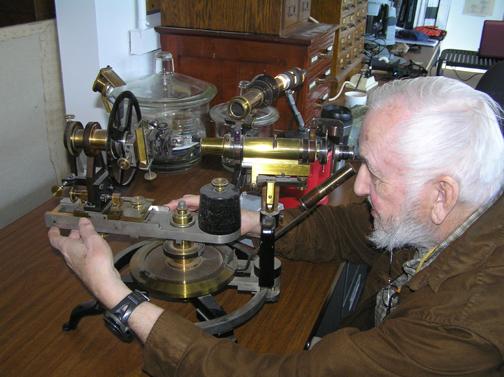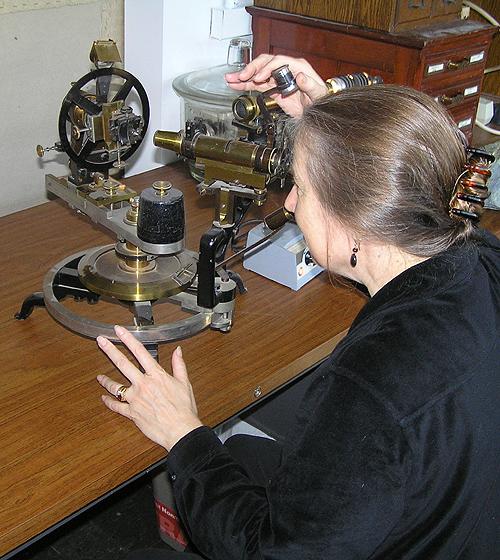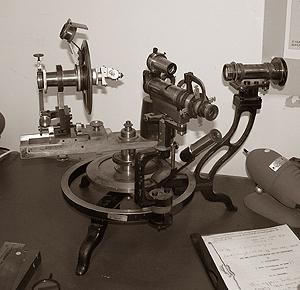| View previous topic :: View next topic |
| Author |
Message |
Elise

Joined: 22 Dec 2009
Posts: 243
Location: New York State



|
 Posted: Mar 02, 2011 21:13 Post subject: Goniometers and mineralogical instrumentation Posted: Mar 02, 2011 21:13 Post subject: Goniometers and mineralogical instrumentation |
|
|
Greetings,
For my 100th posting on FMF, I thought I might celebrate by sharing how excited I am to be learning how to use a 2 circle goniometer - almost one year after attending Olaf Medenbach's presentation on the subject at the Rochester Symposium. I had come home from that eager to get one of these elegant instruments out of the display case and start using it. The trouble - as with everything - is time; but now a mineralogist is flying across the country on Monday just to use this particular model and so we were moved to get it out and clean the dust off. That translates into my wish coming true. First practice was with a topaz crystal - very appropriate since my issue of Lithographie Topaz just arrived.
This instrument was made in Heidelberg, Germany, and though I am not sure of the vintage, I imagine it is from sometime between 1890-1920 (no date stamp). I am going to contact Olaf to see if he recognizes it. Albeit a bit dusty as you can see, it is in fine working order, having spent most of its life being used by a succession of Cornell professors, including Dr. Bassett who taught its use in his undergraduate classes. Upon his retirement, it was relegated to the museum display.
I think that just as I enjoyed learning celestial navigation from my father who taught it with a sextant (before the days of GPS and other instrumentation), this method of analyzing crystals appeals to me immensely. One question to Bill was what light source was used before the advent of those such as the powerful one we are using here (balanced on the red Maxwell House coffee canister) -- I just want to be prepared if Armageddon comes. This is going to take a while to get the hang of -- perhaps other FMF members might have a similar interest in classic instrumentation...sans digital readouts and error messages...
A brief reference: Wight, F.W. (1942). Methods and instruments used in mineralogy. American Mineralogist Volume 27, pages 145-154: www(dot)minsocam(dot)org(slash)msa(slash)collectors_corner(slash)arc(slash)instrument(dot)htm
Best wishes,
Elise
| Description: |
| Biil Bassett setting up the 2 circle goniometer with a topaz crystal. |
|
| Viewed: |
28248 Time(s) |

|
| Description: |
|
| Viewed: |
28229 Time(s) |

|
_________________
Elise Skalwold |
|
| Back to top |
|
 |
Malcolm Southwood
Joined: 04 Feb 2011
Posts: 15
Location: Melbourne



|
 Posted: Mar 02, 2011 21:53 Post subject: Re: Goniometers and mineralogical instrumentation Posted: Mar 02, 2011 21:53 Post subject: Re: Goniometers and mineralogical instrumentation |
|
|
Hi Elise,
This is my first post to FMF in reply to your 100th, which I found fascinating. Firstly, I have a love of old scientific instruments, and yours is a beauty. But secondly, I have just spent some time reading in detail a paper by Charles Palache and Lyman Lewis (1927), presenting a detailed study of the crystallography of azurite from Tsumeb, using a very similar instrument.
While the tables of interfacial angles don't exactly make for light reading, the categorisation of different crystal habits and types based on these measurements is extremely useful and, sadly, this type of study seems to be all but absent from modern mineralogy. After reading this paper it crossed my mind that I, too, would like to acquire such an instrument and put it to use.
So I wish you all the very best with your goniometry. The azurite paper, by the way, can be downloaded free of charge from the Mineralogical Society of America website. The reference is:
Palache, C. and Lewis, L.W. (1927) "Crystallography of Azurite from Tsumeb, Southwest Africa, and the Axial Ratio of Azurite" Am.Min. 12 (4) pp 99-143
Cheers
mal
|
|
| Back to top |
|
 |
Elise

Joined: 22 Dec 2009
Posts: 243
Location: New York State



|
 Posted: Mar 04, 2011 07:44 Post subject: Re: Goniometers and mineralogical instrumentation Posted: Mar 04, 2011 07:44 Post subject: Re: Goniometers and mineralogical instrumentation |
|
|
Hi,
I meant to also include the reference: Mineralogical Record 1998 (29,6) "History of the Development of the Crystallographic Goniometer" by Ulrich Burchard. The author writes in closing: "Most goniometers were produced in small series, or as one-of-a-kind models, as the result of close cooperation between important crystallographers and the leading instrument makers. They are irreplaceable witness to cultural history and the history of the sciences of mineralogy and crystallography. In these specialized instruments the perfection of the craft of the precision machinist and optician was combined with a large measure of esthetic sensibility."
I had a wonderful note back from Olaf; an excerpt follows:
"....(this) goniometer is THE classical Goldschmidt goniometer (the famous crystallographer Victor Mordechai Goldschmidt, not the geochemist Victor Moritz Goldschmidt). He was professor in Heidelberg, and constructed this apparatus together with Peter Stoe. The Stoe Company (www(dot)stoe(dot)com(slash)pages(slash)about(dot)html) built this kind of goniometers between 1895 and about 1940. They were the basis for their X-ray goniometers which they produce until present.
Your instrument is of about 1900 to 1920 vintage. Please check whether the signature (on most instrument on the dust cover of the horizontal circle) reads only Stoe, or Stoe & Rheinheimer. The latter signature was used after 1909 when Fritz Rheinheimer took over the Company.
This model is No. A of their production line, and was certainly the most important such instrument worldwide. There were others, some of them more sophisticated, but the Stoe-Goldschmidt was accurate and easy to handle, and thus got the widest distribution. Undoubtly most of goniometric measurements between 1900 and 1950 have been carried out with this instrument.
Goniometers are in general scarce, and optical goniometers as this one particularly. Uli Burchard, an expert who has visited all major collections worldwide estimated the total amount of optical goniometers of all makers to be less than 800!....."
(it is the latter signature)
When I visited Darko Sturman, Curator Emeritus Royal Ontario Museum in 2007, he showed me the instrument he used throughout his career - this was my introduction to goniometers. It looks very similar to the one I am presently learning to use.
Best wishes,
Elise
| Description: |
| D. Sturman, Royal Ontario Museum (photo: E. Skalwold) |
|
| Viewed: |
28154 Time(s) |

|
_________________
Elise Skalwold |
|
| Back to top |
|
 |
Elise

Joined: 22 Dec 2009
Posts: 243
Location: New York State



|
 Posted: Apr 10, 2012 11:56 Post subject: Re: Goniometers and mineralogical instrumentation Posted: Apr 10, 2012 11:56 Post subject: Re: Goniometers and mineralogical instrumentation |
|
|
| Elise wrote: | | ...... I thought I might celebrate by sharing how excited I am to be learning how to use a 2 circle goniometer - almost one year after attending Olaf Medenbach's presentation on the subject at the Rochester Symposium. I had come home from that eager to get one of these elegant instruments out of the display case and start using it...... |
Hi,
Now two years after Olaf's presentation and one year in the making (I didn't realize just how long it takes to get anything through the publishing process!), the results of that desire to learn how to use the goniometer has finally been realized in the latest Gems & Gemology journal which came out today (the instrument looks slightly less dusty in the my published photos than in the ones I posted above):
Andy H. Shen, William A. Bassett, Elise A. Skalwold, Nicole J. Fan, and Yong Tao (2012) Precision measurement of inter-facet angles on faceted gems using a goniometer. Gems & Gemology, Vol. 48, No. 1, pp. 32-38.
https://www.gia.edu/research-resources/gems-gemology/issues/spring2012-contents/spring-2012-shen.html
(link normalized by FMF)
It was a lot of fun to do, not just working with the instrument, but also doing so with my co-authors. Andy, a research scientist at GIA, had this idea for the goniometer and is who brought this project back to us at Cornell where he had been a graduate student of Bill's. He and Bill were already proficient with the goniometer, so I had very fine instructors in learning how to use the instrument and for brainstorming how to use it in an unusual way. It is in the context of faceted gems, but the whole process gave insights for me into what is perhaps becoming a lost art. This week I was happy to share the results with Olaf who had been such an inspiration in the first place! Now I hope to get back to practicing on crystals!
Best wishes for the upcoming Rochester Symposium!
Elise
_________________
Elise Skalwold |
|
| Back to top |
|
 |
cascaillou
Joined: 27 Nov 2011
Posts: 257


|
 Posted: May 20, 2012 07:03 Post subject: Re: Goniometers and mineralogical instrumentation Posted: May 20, 2012 07:03 Post subject: Re: Goniometers and mineralogical instrumentation |
|
|
classical gemology tools can be used for identification of minerals:
10x triplet loupe
polariscope + conoscope (these are of no use for opaque samples)
dichroscope (of no use for opaque samples or colorless samples)
spectroscope (of no use for opaque samples)
refractometer (you can get a full reading from a smooth and flat crystal facet, but an approximative spot reading is still possible otherwise)
LWUV/SWUV lamp
milligram scale + specific gravity kit
gemological microscope
gem data book (so to make sense of the data collected through the use of the above mentionned tools)
of course, these tools are useless if you can't interpret tests results correctly, so one first need to learn all the basics of gemology and also involve in some serious practical training.
|
|
| Back to top |
|
 |
arturo shaw

Joined: 23 Oct 2009
Posts: 89



|
 Posted: May 21, 2012 02:52 Post subject: Re: Goniometers and mineralogical instrumentation Posted: May 21, 2012 02:52 Post subject: Re: Goniometers and mineralogical instrumentation |
|
|
Hi,
Now that we are talking goniometers... Does anybody have information on "affordable" modern laser goniometers? (I don't think I can afford a beauty like the one Elisa is using up there).
Any info would be welcome.
Thank you
Arturo
|
|
| Back to top |
|
 |
Elise

Joined: 22 Dec 2009
Posts: 243
Location: New York State



|
 Posted: May 21, 2012 22:59 Post subject: Re: Goniometers and mineralogical instrumentation Posted: May 21, 2012 22:59 Post subject: Re: Goniometers and mineralogical instrumentation |
|
|
| cascaillou wrote: | | classical gemology tools can be used for identification of minerals...of course, these tools are useless if you can't interpret tests results correctly, so one first need to learn all the basics of gemology and also involve in some serious practical training. |
While these are already of use to people interested in minerals (though perhaps in another guise), many gemologists could benefit significantly by studying mineralogy and would find that their bench and field instruments are capable of revealing a great deal more information than what is taught through gemological training alone. Those instruments have their roots in optical mineralogy and other [geological] sciences, but are for the most part used by rote "blindly", without fully understanding underlying concepts - a casualty born of the vocational necessity to work very quickly at identifications. As a gemologist, that was a frustration for me and led to entering the study of mineralogy itself ( I am lucky to be in the realm of research rather than fast-paced gem dealing - it gives one time to ponder).
Along with FMF and MinDat, a fine text is Mineral Identification: A Practical Guide for the Amateur Mineralogist, by Donald B. Peck. A section of his book is entitled "Instruments You Can Make" where he describes how to construct deceptively simple instrumentation from inexpensive materials, including the specific gravity balance, magnetometer, dichroscope, polarizing microscope, prism refractometer, single circle goniometer, two circle goniometer for the microscope and spindle stage.
https://www.minrec.org/bookdetail.asp?id=48
Best wishes,
Elise
PS -- you have a typo above re spectroscope - opaque specimens: use oblique reflected light.
_________________
Elise Skalwold |
|
| Back to top |
|
 |
arturo shaw

Joined: 23 Oct 2009
Posts: 89



|
 Posted: May 22, 2012 11:19 Post subject: Re: Goniometers and mineralogical instrumentation Posted: May 22, 2012 11:19 Post subject: Re: Goniometers and mineralogical instrumentation |
|
|
I have that book, Elise, but not feel very confident in building those instruments... :-)
Thank you
Arturo
|
|
| Back to top |
|
 |
|


